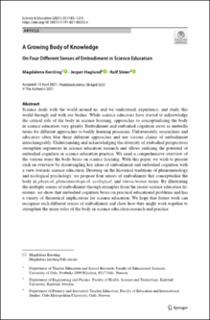| dc.contributor.author | Kersting, Magdalena | |
| dc.contributor.author | Haglund, Jesper | |
| dc.contributor.author | Steier, Rolf | |
| dc.date.accessioned | 2022-02-21T10:38:08Z | |
| dc.date.available | 2022-02-21T10:38:08Z | |
| dc.date.created | 2021-04-28T19:57:44Z | |
| dc.date.issued | 2021-04-28 | |
| dc.identifier.issn | 0926-7220 | |
| dc.identifier.issn | 1573-1901 | |
| dc.identifier.uri | https://hdl.handle.net/11250/2980448 | |
| dc.description.abstract | Science deals with the world around us, and we understand, experience, and study this world through and with our bodies. While science educators have started to acknowledge the critical role of the body in science learning, approaches to conceptualising the body in science education vary greatly. Embodiment and embodied cognition serve as umbrella terms for diferent approaches to bodily learning processes. Unfortunately, researchers and educators often blur these diferent approaches and use various claims of embodiment interchangeably. Understanding and acknowledging the diversity of embodied perspectives strengthen arguments in science education research and allows realising the potential of embodied cognition in science education practice. We need a comprehensive overview of the various ways the body bears on science learning. With this paper, we wish to present such an overview by disentangling key ideas of embodiment and embodied cognition with a view towards science education. Drawing on the historical traditions of phenomenology and ecological psychology, we propose four senses of embodiment that conceptualise the body in physical, phenomenological, ecological, and interactionist terms. By illustrating the multiple senses of embodiment through examples from the recent science education literature, we show that embodied cognition bears on practical educational problems and has a variety of theoretical implications for science education. We hope that future work can recognise such diferent senses of embodiment and show how they might work together to strengthen the many roles of the body in science education research and practice. | en_US |
| dc.description.sponsorship | Open access funding provided by University of Oslo (incl Oslo University Hospital). | en_US |
| dc.language.iso | eng | en_US |
| dc.publisher | Springer | en_US |
| dc.relation.ispartofseries | Science & Education;30 (2021) | |
| dc.rights | Navngivelse 4.0 Internasjonal | * |
| dc.rights.uri | http://creativecommons.org/licenses/by/4.0/deed.no | * |
| dc.subject | Science education | en_US |
| dc.subject | Embodied cognition | en_US |
| dc.subject | Embodiment | en_US |
| dc.subject | Embodiment senses | en_US |
| dc.title | A growing body of knowledge | en_US |
| dc.type | Peer reviewed | en_US |
| dc.type | Journal article | en_US |
| dc.description.version | publishedVersion | en_US |
| dc.rights.holder | © The Author(s) 2021 | en_US |
| dc.source.articlenumber | 30 | en_US |
| cristin.ispublished | true | |
| cristin.fulltext | original | |
| cristin.qualitycode | 1 | |
| dc.identifier.doi | https://doi.org/10.1007/s11191-021-00232-z | |
| dc.identifier.cristin | 1907076 | |
| dc.source.journal | Science & Education | en_US |
| dc.source.pagenumber | 1183–1210 | en_US |

